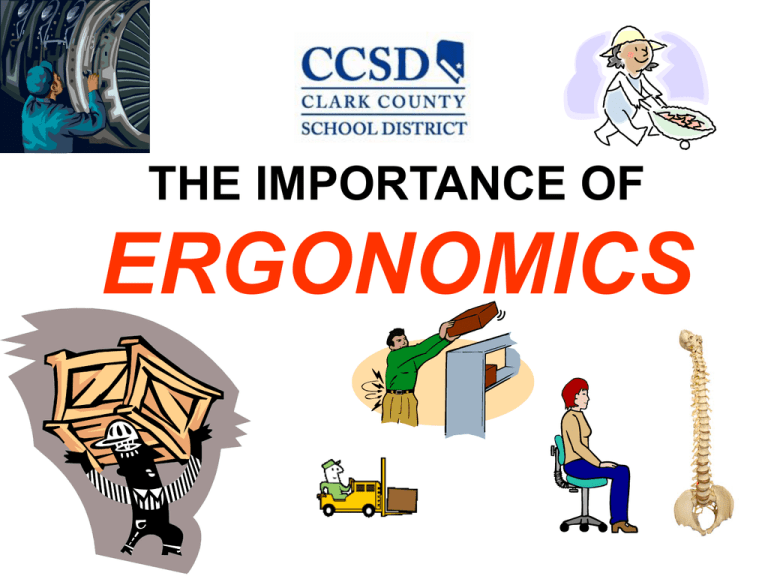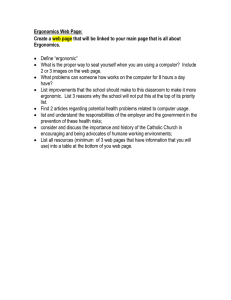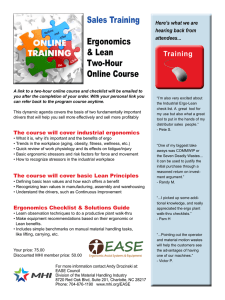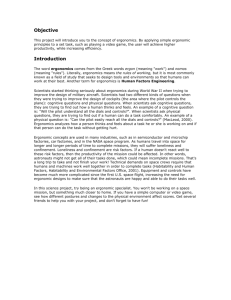ERGONOMICS THE IMPORTANCE OF
advertisement

THE IMPORTANCE OF ERGONOMICS MAINTENANCE DEPT. TOP 10 WORK COMP INJURY CAUSES IN 2010 ERGONOMIC INJURIES….. (TWISTING, LIFTING, PUSHING, PULLING, STRAIN, REPETITVE MOTIONS, ETC) 15 - INJURIES THE COST ……$$$$$ • TOTAL INJURIES IN MAINTENANCE DEPT: 55 in 2010 • TOTAL INCURRED MEDICAL EXPENSES FOR MAINTENANCE DEPT = $178,303.45… ERGONOMICS BASED : $139,344.04 (78%) • (REMEMBER THIS IS ONLY THE TOP 10 FOR ONLY THE MAINTENANCE DEPARTMENT)! • ADD IN THE LOST TIME, INTRUPTION TO SERVICE, POSSIBLE OVER TIME….. THIS EXPENSE CAN EASILY DOUBLE! • AND DON’T FORGET ABOUT THE IMPACT TO THE INJURIED EMPLOYEE AND THEIR FAMILY! OSHA…. ERGONOMICS Ergonomics is the science of fitting workplace conditions and job demands to the capabilities of the working population. Effective and successful "fits" assure high productivity, avoidance of illness and injury risks, and increased satisfaction among the workforce. Although the scope of ergonomics is much broader, the term here refers to assessing those work-related factors that may pose a risk of musculoskeletal disorders and recommendations to alleviate them. Common examples of ergonomic risk factors are found in jobs requiring repetitive, forceful, or prolonged exertions of the hands; frequent or heavy lifting, pushing, pulling, or carrying of heavy objects; and prolonged awkward postures. Vibration and cold may add risk to these work conditions. Jobs or working conditions presenting multiple risk factors will have a higher probability of causing a musculoskeletal problem. The level of risk depends on the intensity, frequency, and duration of the exposure to these conditions and the individuals' capacity to meet the force of other job demands that might be involved. OSH Act of 1970 SEC. 5. Duties (a) Each employer -(1) shall furnish to each of his employees employment and a place of employment which are free from recognized hazards that are causing or are likely to cause death or serious physical harm to his employees; (2) shall comply with occupational safety and health standards promulgated under this Act. 29 USC 654(b) Each employee shall comply with occupational safety and health standards and all rules, regulations, and orders issued pursuant to this Act which are applicable to his own actions and conduct. BREAKING YOUR BACK The average human head weighs about 8 pounds—in a posture-perfect, eyes-forward position. But if your chin moves forward just 3 inches—as it tends to do when you work at a computer—the muscles of your upper torso must support the equivalent of 11 pounds. That's a weight-bearing increase of 38 percent, often for hours at a time. The result of such chronic slumping: Rounded shoulders, an aching neck, and persistent back pain—the anatomical hallmarks of the modern desk jockey. FIT THE JOB TO THE PERSON Many companies have made substantial efforts to reduce work-related injuries due to heavy lifting, repetitive motion, awkward work postures, vibrations, and other recognized ergonomic stressors. The results achieved by these companies demonstrate that there are effective and affordable ways for supervisors in industries to protect their employees from injury while maintaining, and in some cases, increasing quality, productivity and employee morale. Ergonomics (ur-go-NOM-ix): Ergonomics is the scientific study of people at work. The goal of ergonomics is to reduce stress and eliminate injuries and disorders associated with the overuse of muscles, bad posture, and repeated tasks. This is accomplished by designing tasks, work spaces, controls, displays, tools, lighting, and equipment to fit the employee's physical capabilities and limitations. Ergonomics addresses problems ♦ work tables and chairs such as: that are too high or too low ♦ lights that are not bright enough or that produce glare ♦ noises that are too loud ♦ jobs that put hands, arms, or backs into awkward positions ♦ proper ergonomic practices can make your job easier and keep your work force safer ♦ Full arm length shows how far a person can be expected to reach. If the person with the shortest arms can reach everything easily, other people can too. ♦ Forearm length approximates how far the work area should be from the person, which is usually 18-inches for a small operator. ♦ Thigh thickness shows how deep the space below the table needs to be for sit-down jobs. If the space is big enough to fit large thighs, smaller thighs will fit too. ♦ Lower leg length shows how far the seat of a chair should be from the floor. A person should be able to adjust the chair for short legs or long legs. Full Arm Length Forearm Length Thigh Thickness Lower Leg Length These are the body parts that a work station needs to fit Very fast hand and wrist movements, done repeatedly and with force, can cause tiredness, pain, weakness, and injury. ♦ Jobs should be designed so that employees can keep their wrists straight and use as little hand motion as possible. ♦ Work methods should be analyzed to insure wrists and body segments are kept in neutral posture. ♦ Employees should be trained to avoid using more force and movement than a job requires. Painful, tired muscles can also happen when an employee does any of the following: ♦ uses one or more muscles too much or too often ♦ does something the muscles are not strong enough to do (for example, lifting heavy loads) ♦ uses muscles for a prolonged period (static muscle loading) THE 20-20 RULE Every 20 minutes, stand for 20 seconds and stretch or shake things out. “Just 20 seconds away from your computer screen or field work reduces fatigue and increases blood circulation”. ANYTHING WRONG HERE??? ♦ Employees should be able to work with the elbows down, close to the body. ♦ Employees should have to reach no farther than 18-inches to the front. ♦ Employees should be able to rest their arms, but not against sharp edges. ♦ Employees should not have to twist and bend to pick-up or putdown objects. ♦ Employees should not have to reach behind themselves. ♦ Where possible, the work should be designed so that employees change between sitting and standing throughout the work day. Ergonomic Stressors ♦ Lower back pain of acute origin is generally attributed to muscle strains of the lumbar region. Poor lifting mechanics, heavy loads and/or repetitive exertions are often cited as activities that precede the acute injury. ♦ Common muscle strains occur in the shoulders, upper arms, forearms, and lower back. Ergonomic Stressors ♦ Vibration—This term refers to physical exposure to a vibration source, such as a tow motor operator or a hand tool. We evaluate vibration exposure by looking at the magnitude, the frequency, and the duration of exposure. ♦ Contact Stress—Physical contact between the body and sharp edges of tools, workstations, equipment, and products can cause compression of blood vessels and nerves. Ergonomic Stressors ♦ Environmental Factors Environmental factors include: cold, heat, light, noise, and moisture. All of theses factors define a work environment and should be evaluated individually for hazards. ♦ Multiple Stressors Many jobs combine multiple stressors in a single job. The combination of multiple stressors within a job or work task can increase risk of injury. The impact of ergonomic stressors is affected by duration of exposure, lack of recovery time, and the combination of multiple stressors. An employee who has hurt a tendon or its cover, might have one or more of the following symptoms: ♦ sharp or dull pain ♦ burning feeling ♦ swelling ♦ crackling or popping sounds when the part that is hurt moves ♦ loss of some or all use of the part that is hurt THE NUMBERS PER: U.S. Bureau of Labor Statistics ♦ Injuries to the back generate the highest frequency of disabling injuries. ♦ $86 billion a year is spent treating neck and back pain, more than any other ailment. ♦ Ergonomic disorders are the fastest growing category of workrelated illness, they account for 56-63 percent of illnesses reported to OSHA. IT’S INEVITABLE…… 80% OF US WILL SUFFER BACK PAIN AT SOME POINT IN OUR WORKING LIVES PREVENTION IS THE KEY!!!


